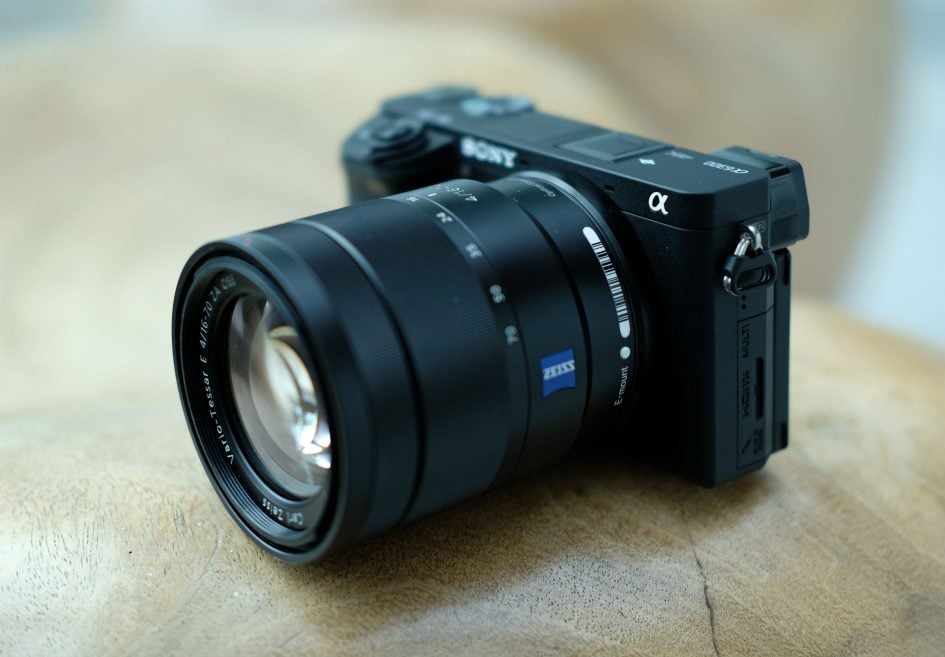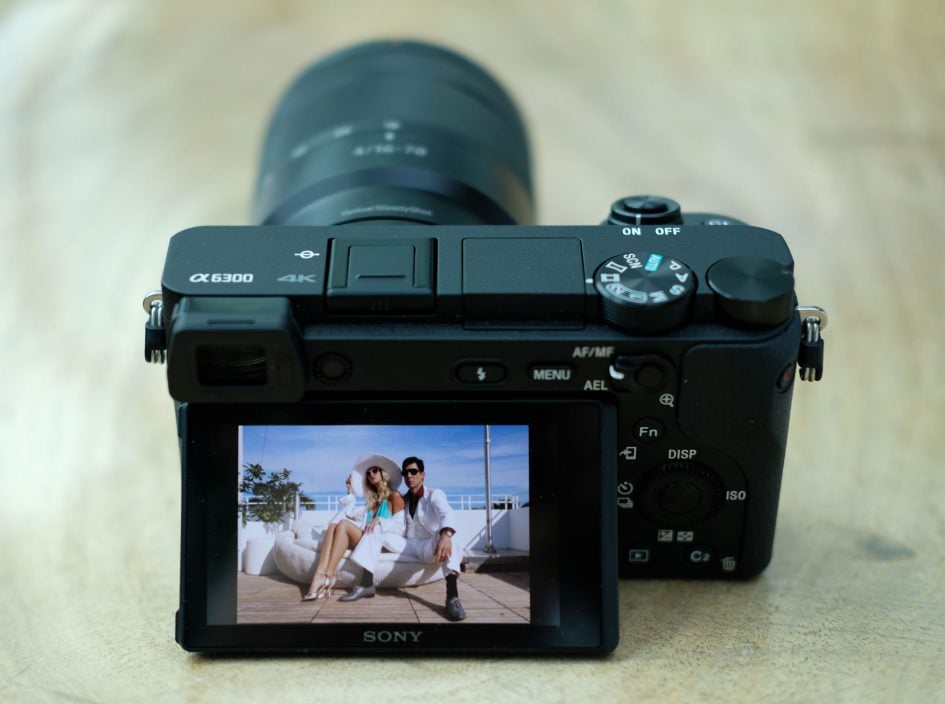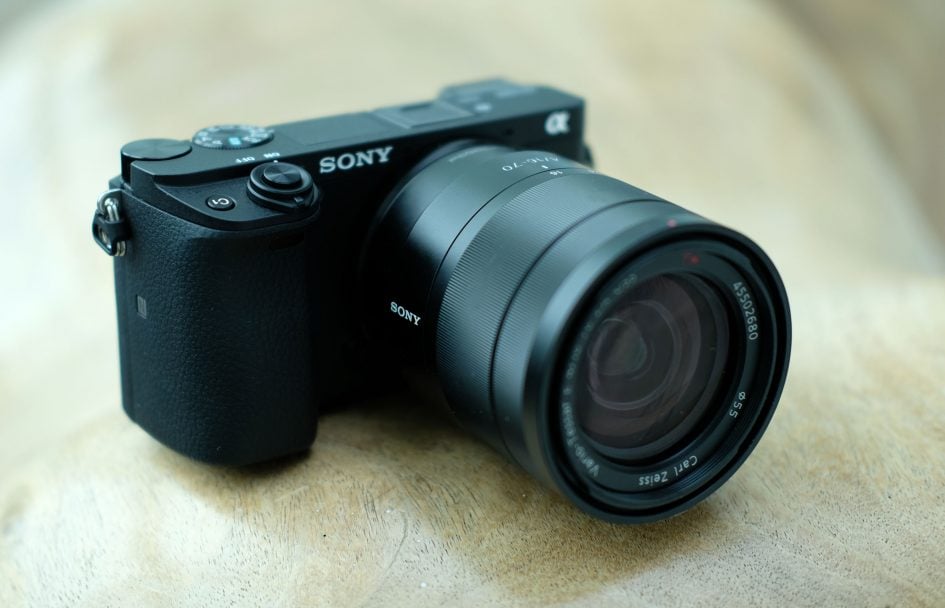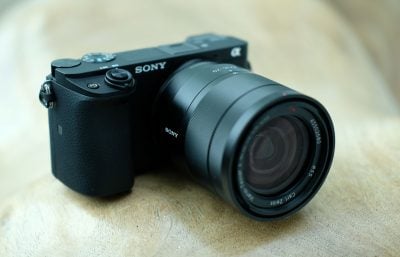Sony Alpha A6300 review
-
-
Written by Gordon Laing
Verdict
Sony’s A6300 is a mid-range mirrorless with an AF system that’s the envy of pro cameras costing up to twice the price. It takes the earlier A6000 – no slouch for action photography – and upgrades the weather-sealing and viewfinder, adds 4k video, 1080 at 120p for slow motion and a microphone input, while greatly improving the autofocus with a dense array of phase-detect points covering almost the entire sensor area and making it more useful with a live update between frames when shooting bursts. Phew.
Like its predecessor, the AF and drive systems are the highlight, allowing the A6300 to confidently track fast-moving subjects across the entire frame and record a high degree of keepers at up to 11fps. Where the A6300 scores above the A6000 though are a much higher density of phase-detect AF points, superior subject recognition and tracking and, most importantly of all, a new drive mode that provides a live update between frames with minimal viewfinder blackout. Finally, the ability to follow unpredictable subjects while shooting as easily as you would with a DSLR viewfinder, and while the speed falls slightly to 8fps it’s still fast and again coupled with a highly effective AF system.
As detailed in my main review, it all really works in practice and for the money makes the A6300 the best camera for sports and action photography – not to mention active kids and pets. But it’s more than a one-trick pony. With internal 4k video, 1080 at up to 120fps, Picture Profiles for subsequent grading and confident refocusing during movies, the A6300 also becomes one of the best video cameras at its price point. Yep, if you’re into shooting action or filming 4k movies, you’re gonna love the A6300.

In terms of image quality, don’t expect a huge step-up from the A6000 nor indeed most other 24 Megapixel cameras with APSC sensors. I’d say the A6300 is slightly better at very high ISOs compared to the A6000, but not enough to upgrade. The bigger issue for image quality is the lens you pair the camera with. That of course applies to any camera, but it can be a challenge for Sony’s APSC models as the two most common general-purpose zooms, the 16-50mm f3.5-5.6 and 16-70mm f4, don’t make the most of the sensor especially at wide angle. I’d like to see a new E-mount general-purpose zoom from Sony that really does these bodies justice.
If you’re filming 1080p, there’s also not a great deal of difference between the A6300 and the A6000, but switch the new model to 4k and you’ll enjoy considerably greater detail. Down-sampling 4k to 1080 also produces great results and is the preferred route for Full HD projects, although doing so limits you to the maximum 4k frame rates of 24, 25 and 30p. As noted in my main review, there have also been reports of rolling shutter artefacts, but when filming carefully – even handheld – I didn’t notice it in my clips. The problem with a small and light camera is they’re easier to throw around and therefore seem more susceptible to rolling shutter, but anyone who is into lively handheld footage would be advised to research further.
Owners of the older A6000 – which include me – will also appreciate the weather-sealing, XGA viewfinder resolution, microphone input and a dual-axis levelling gauge when composing. But it’s important to remember most of these have long been on the competition and as such Sony is simply playing catch-up. It’s also revealing to note the much earlier Sony NEX-7 featured an XGA viewfinder, mic input and dual-axis levelling gauge and that they were all down-graded or removed for the A6000, presumably to make room for a higher-end option which never materialised. So a lot of the upgrades on the A6300 are simply re-instating what should never have been taken out of the A6000 in the first place.
Indeed if you put these aside, the main thing that’s new on the A6000 is the sensor and its ability to film 4k video and pack-in a higher-density PDAF system. While the new capabilities of the sensor are undeniably welcome, I’m concerned to find many of my complaints about the A6000 inherited here.

My biggest issues are the screen and control system. I’ve detailed both in the main review, but I’ve never been a fan of the A6000’s dials. I feel it needs a front dial and both it and the rear dial need more tactile clicks. I also think the A6300 could have been so much better with a fully-articulated screen that’s also touch-sensitive. It seems a criminal shame to have such a great AF system, yet make it so hard to move the AF area when a touch-screen or even an AF joystick could have solved the issue immediately. As someone who regularly shoots in the portrait orientation, a screen that only tilts vertically won’t help me compose at high or low angles, and its inability to flip round to face the subject rules it out for vloggers or even simple selfies. The 16:9 screen shape also means normal photos are displayed smaller than rival cameras and like the A6000, the screen needs to be brightened for comfortable daytime use – except you can’t when filming 4k video as the brightness option is greyed-out to avoid over-heating.
Speaking of bright conditions, the A6300 also really needs a shutter speed faster than 1/4000 even if it’s only electronic. I regularly bumped against this limit when shooting with large aperture lenses in daylight, even at 100 ISO.
Indeed I feel the day-to-day operation of the camera is simply-bettered by other cameras on the market at a similar price point. Models like the Olympus OMD EM5 Mark II (cheaper), Panasonic Lumix G7 (much cheaper) and Canon EOS 80D (a little pricier) for instance which all feature fully-articulated touch-screens, 1/8000 shutters (albeit only electronic on the G7), and arguably better control systems. I’ve linked to my reviews of each of them here.
Of course there’s pros and cons to each of them. The Olympus features built-in stabilisation, the Panasonic embraces 4k for movies and stills photography and the Canon offers the chance to shoot with a great live view system or a traditional DSLR optical viewfinder. But both the Olympus and Panasonic have smaller Micro Four Thirds sensors and inferior continuous AF, while the Canon is larger, heavier and more expensive.
But of this group, only the Sony A6300 offers 4k video on an APSC sized sensor and the broadest and densest array of phase-detect AF points for unrivalled continuous autofocus. Yes, once again we’re back at action photography and 4k movies, the two areas where the A6300 excels.
Sony A6300 final verdict
The Sony A6300 is an exceptional camera for action and sports photography. Nothing comes close for the money and in many situations it’ll rival or beat DSLRs costing almost twice as much. It’s also very good for video, again rivaling higher-end models in 4k.

I may have bugbears with the controls and screen inherited from the A6000, but I equally appreciate these are personal and others may disagree. But I still feel for day-to-day photography you may prefer the shooting experience of alternative models. I know I do.
I personally feel the A6300 has gone the same way as the RX100 Mark IV, delivering an upgrade based mostly on Sony’s prowess on sensor technology. Did anyone ask for an AF upgrade over the A6000 or a bunch of slow motion modes over the RX100 Mark III? I don’t think so, and while they’re undoubtedly impressive and nice to have, in the absence of improvements to their general usability they’ve both become specialist cameras.
So here’s the bottom line: if you want a camera for general use, by all means consider the A6300, but do think carefully about what lens you’ll couple it with and also be sure to pick-up and compare the handling with rival cameras. If you mostly shoot action the A6300 becomes the best in its class and by delivering 4k on an ASPC sensor with Picture Profiles and great autofocus, it also becomes arguably the best movie camera for the money too. If you don’t need 4k video and are happy with a ‘mere’ 169 embedded phase-detect AF points, then the earlier A6000 is also well worth considering, especially at its increasingly discounted price.
Ultimately I commend Sony on its sensor technology which is racing ahead of the competition. The autofocus and movie capabilities of the A6300’s sensor are truly impressive, and by eliminating viewfinder lag, they’ve also addressed one of the remaining benefits DSLRs had over mirrorless cameras. I just wish they’d invest as much effort into control and ergonomics as my issues with them hold the A6300 back from my top award.
PS – several months after this review I took the A6300 to the 2016 Tour de France and you can find out how it performed in my Shooting the Tour de France 2016 article!
Good points
Best continuous AF in its class.
Fast 11fps burst shooting or 8fps with live update.
Internal 4k video. 1080 at up to 120fps for 5x slo-mo.
Compact and light, weather-sealed body.
Wifi with NFC and downloadable apps.
Bad points
Screen not touch-sensitive nor fully-articulated.
Control dials have minimal tactile feedback.
Screen can’t be brightened when filming 4k.
Maximum shutter speed of 1/4000.
Smart Remote app needs updating immediately.
Downloaded apps often have separate menus.
Reports of rolling shutter, but not on my clips.




